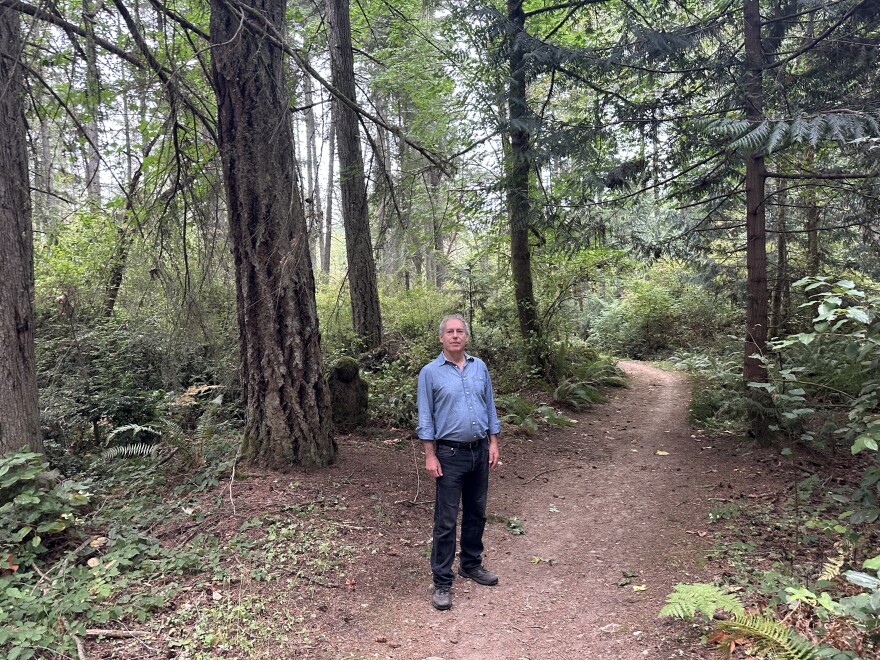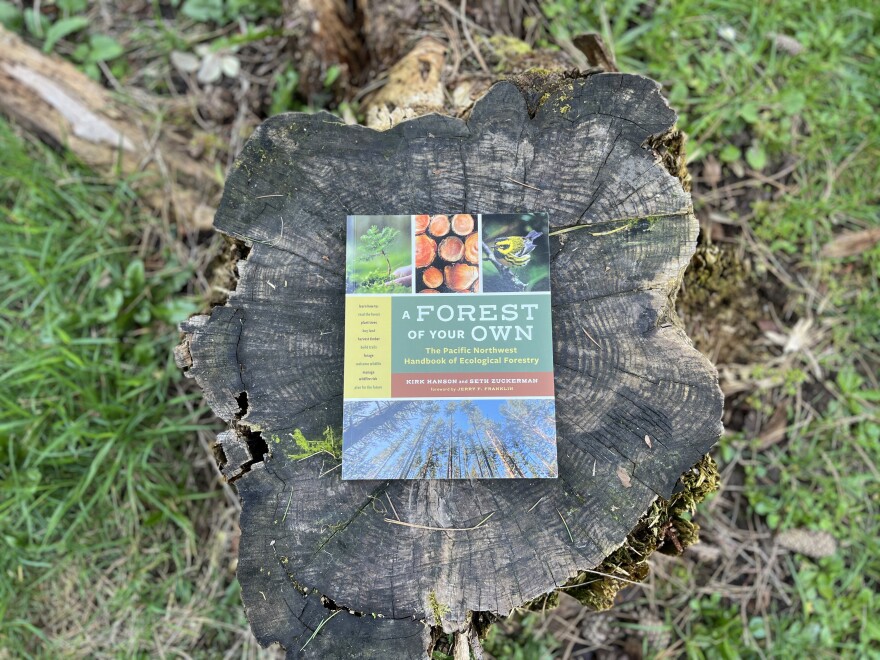Ecological forestry is an approach to resource management that is gaining momentum in the Northwest. Unlike industrial forestry, it doesn’t primarily focus on maximizing returns for investors. Instead, it looks to provide benefits for multiple stakeholders and manages for long-term sustainability.
Seth Zuckerman is the co-author of the 2024 book, A Forest of Your Own and an advocate for ecological forestry. KNKX reporter Bellamy Pailthorp went to meet him on Vashon Island to see some of his ideas in action at King County’s Island Center Forest.
Click “Listen” above to hear their conversation, or find the transcript below.
Transcript
Note: This transcript is provided for reference only and may contain typos. Please confirm accuracy before quoting.
KNKX Environment reporter Bellamy Pailthorp: Seth Zuckerman, you are the executive director of a nonprofit that promotes ecological forestry and A Forest of Your Own is a guide to that. It's almost like a textbook. First, what is ecological forestry and how does it compare to industrial style forestry?
Author Seth Zuckerman: So, ecological forestry is an approach to the forest that looks at it as a whole system, a holistic view, that instead of treating it just as a place to produce a commodity or a place to recreate, it thinks of all the aspects: how do you keep the forest as a larger being, intact, healthy and thriving? And that can include, of course, the production of timber, alongside storing carbon, protecting watershed values, spiritual and recreational values and so on.
I'd say that industrial forestry, particularly in recent times, has come to focus on maximizing the rate of return to investors. And so what that leads to is cutting the forest as soon as the trees become merchantable, and then planting another what they see as a ‘crop’ of trees. Well, we see the forest as more than just a field where you grow crops. It's also a place where you grow a whole bunch of other things, and you provide habitat for other creatures, including human beings.
Pailthorp: Ultimately, your goal would be to see less of this plantation-style timber production and more ecological forestry. So how do you expand it? Is there a process of conversion from those industrial style forests to ecological ones?
Zuckerman: Absolutely. In fact, we work with a number of land trusts and community forests. They're in the process of doing exactly that. They'll buy land from managers of industrial forest plantations, and then they'll work on trying to convert them back to more holistically-managed forests that provide a much wider array of benefits, that will still provide some timber harvest, but also over time, will provide better habitat for the other creatures that use the forest, better watershed outcomes, both for fish and for the people who use the water downstream.
And so, for example, the Nisqually Community Forest, between a nonprofit Land Trust and the Nisqually Indian Tribe have, between them, purchased 5500 acres of land on the west side of Mount Rainier, which they're in the process of converting into more ecologically-managed forests. And that's happening all over the Northwest.

Pailthorp: Yeah. And I mean, we're standing beneath the canopy of lots and lots of towering Doug firs. It looks like they're pretty closely planted together, I think, though, for a lot of people, sort of squaring those values of a park, forest/timber production area is very hard to understand. So I mean, can you really produce timber from this place?
Zuckerman: I think part of the way we've gotten this mess is with artificial dichotomies. A place is either a park and a preserve, or it's a place where you produce timber. And it's our feeling that through ecological forestry, you can actually, in a lot of places, do both. And so people come through here, running all the time and walking and just enjoying the forest, playing capture the flag, and at the same time, periodically, you can close a small section of the forest and come in here with heavy equipment and skillfully remove maybe a third of the trees.
Pailthorp: Can people make a living off of ecological forestry? I mean, does managing the land in this way, with these multiple values, create jobs?
Zuckerman: Oh, absolutely. In fact, our organization works with landowners to manage harvests like this, and we work with logging contractors who are making their livings doing this, and then that the wood that they harvest then goes into lumber and veneer mills, and that is also supporting even more jobs. So I would say absolutely.
Pailthorp: What about demand for wood? Don't we still need lots and lots of wood for construction and manufacturing?
Zuckerman: Fundamentally, managing older forests will actually produce more timber in the long run than the sort of industrial management that's practiced across most of Western Washington.
The reason being that if you clear cut the forest every 40 years, as they tend to do, the next five or 10 years, while the little seedlings are growing up, it’s almost wasted time. From the standpoint of ecological productivity, most of the photons that are driving the growth of these amazing forests that we have here in the Northwest, they're falling in between the trees, and so they're going to waste.
But if you manage mature forests, or even if you clear cut them less frequently, so you clear cut them only every 80 years, then you would be in a position where those five or 10 wasted years wouldn't matter as much. And so ultimately, you find that the production of timber is greater if you grow older trees, not along these sort of industrial lines.
Pailthorp: But, it does require longer-term thinking and a lot more patience, I think, in terms of the output, right?
Zuckerman: Absolutely, yeah, you have to think long term. And I think forests – you know, when you're standing next to a tree that could easily live 500, 700, 800 years – that ought to encourage you to think long term.
Pailthorp: You have followed forests for a long time. Do you feel like the desire for this is growing?
Zuckerman: Absolutely. You know, when I started working on forestry issues, we were in the heart of what was called the "Timber Wars," right? The struggle over the last old growth on public land and whether it would be harvested or not.
And I think over time, as the arguments over old growth have been put to bed, we're facing the question of really, what's the next chapter of forest stewardship in our region, and what is that going to look like? Is it going to be driven solely to provide the maximum, quickest investment returns to investors who are located in distant urban centers? Or is it going to be to provide long-lasting management that both supports rural communities and also supports the long term health of the forest?
And so I think the fact that the conversation is shifting in that direction to that question of who should the forest benefit now that we are going to manage these second growth and third growth forests that we have, that's the right question for us to be asking.
Pailthorp: Seth Zuckerman, co-author of A Forest of Your Own. Thank you so much for sharing your ideas.
Zuckerman: Thanks so much for having me here.







